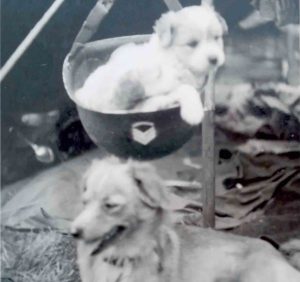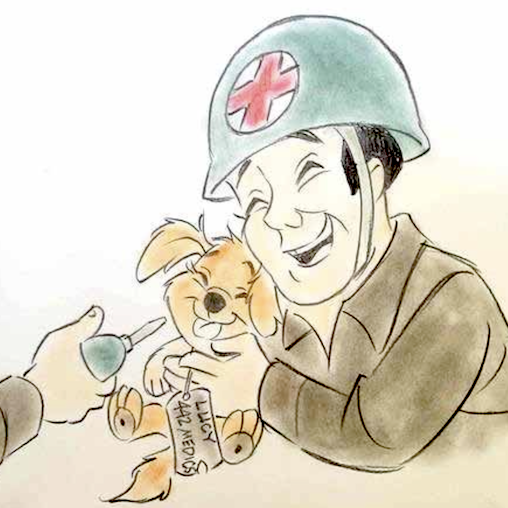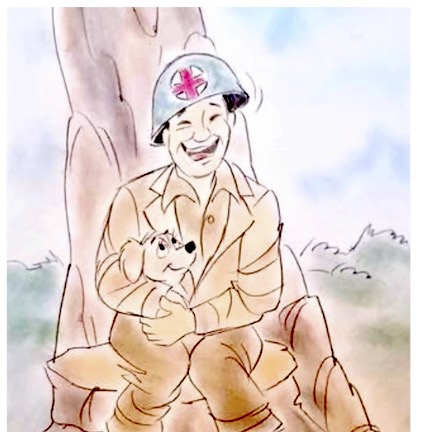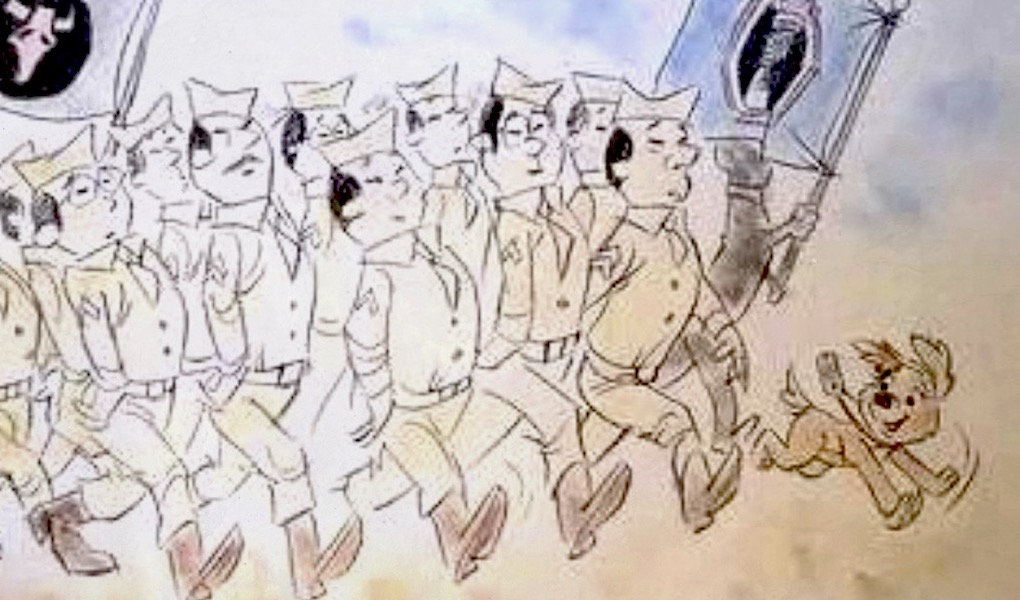Lucy the mascot with her 442nd RCT medics unit as drawn by Willie Ito for “The Story of Lucy”
Lucy, a stray puppy adopted by Nisei medics during WWII,
is now immortalized in a heartfelt picture book
that uncovers her life on the European Front.
But what happened after she came home?
By Lynda Lin Grigsby, P.C. Contributor
Howard Kozuma sported the same close-cropped hairstyle for most of his life — short on top and longer on the sides. To smooth the errant strands away from his ears, he used candlewax.
“I think the top was an Army thing,” said his son, Pat Kozuma, 67. “And the sides, I don’t know.”
For decades, Howard showed up to family events in his signature style — hair slicked, mouth quiet. He was a man of few words who preferred to express himself through action. Whether at his children’s basketball games or booster club meetings, Howard was ever present and ready to help.
These qualities were rooted in his time as a World War II medic with the 442nd Regimental Combat Team. On the European Front, Howard — a Honolulu-born Nisei — saw the worst of war. Wounded soldiers, as Sen. Daniel K. Inouye once said, don’t call out for their mothers on the battlefield. The lucky ones call out for the medics.
Howard, like many Nisei veterans, felt reluctant to unspool war memories. Speaking them aloud carried him back to the mountains of Italy where too many friends called for his help. In 1984, a throat cancer diagnosis and a laryngectomy reduced the bass in his voice. Howard could only talk between deep breaths.

Lucy came from the Italian town of Luciana. She became the 442nd RCT medics’ unofficial mascot.
Then one day, Pat, a general manager at the Aston Waikiki Beach Tower in Honolulu, heard a story that gave him pause — the 442nd RCT medics adopted a puppy in the Italian town of Luciana. The dog, aptly named Lucy, became the unit’s unofficial mascot.
Pat’s hotel job puts him in contact with many people from around the world who want to tell stories. He has heard them all. But when he heard about Lucy, he knew his dad was involved.
At war’s end, one medic took Lucy to Hawaii.
“Was it you who smuggled Lucy back home?” Pat asked his dad.
The Nisei veteran smiled with his whole soul when he heard the name Lucy. Then, he chuckled and took a deep breath.
“That was me,” Howard said.
A Puppy and All Her Dads
The fighting at Luciana was bitter hand-to-hand conflict. In 1944, the 442nd RCT and 100th Battalion had the enemy barricaded with the fierce fighting style that later made them one of the most highly decorated units in Army history.

Lucy and her many dads of the 442nd RCT medics unit
The units’ medical teams — comprised of doctors, dentists and even Boy Scouts with first aid training — received limited combat training and were restricted from carrying guns. Combat medics embedded with troops on the battlefield, lived in foxholes, rendered emergency aid under fire and carried the wounded across miles of treacherous terrain.
“There was no quit,” Dr. Harry Abe, a 442nd RCT medic, recalled in a 1997 interview with Columbia University’s oral history project. “I think we had something we had to prove. That was our motto all the way through.”
During WWII, combat medics relied on the bright Red Cross logo emblazoned on helmets and uniforms to give them special protection. Still, medics were often targeted and killed, according to the Go For Broke National Education Center.

Eddie Yamasaki with Lucy
In Luciana, battered and beleaguered, the 3rd Battalion medics needed a morale boost. They chanced upon local Italian children with a puppy. Maybe, they thought, the dog could live at their camp. They offered the kids candy in exchange for the puppy, then brought Lucy back to camp and fed her with an eyedropper.
Lucy became the heart of a wartime family with so many dads, including Eddie Yamasaki — a bespectacled Nisei from Hawaii with a Leica camera and a penchant of taking photos and creating scrapbooks.
Yamasaki snapped photo after photo of Lucy, documenting her life during WWII from puppy to adulthood cradled in the arms of medics or nuzzled in the faces of infantrymen. She posed happily for photos with her dads, who grew so fond of her that they made her own “Lucy” dog tags. Lucy was a medium-size mutt with long hair along her neck and chest. Her bushy tail swished whenever her dads returned from battle.

Lucy the medic dog, drawn in a helmet by Willie Ito, similar to the real photo of her puppy
When Lucy gave birth, the medics doted on her puppies. Yamasaki proudly took pictures of her expanding family, too.

Lucy with her puppy in an medic’s helmet
At war’s end, the Nisei soldiers trickled back home. Memories of Lucy faded until 2013, when Yamasaki invited Stacey Hayashi, an author and filmmaker, to look at his 442nd photo album. By then, Yamasaki’s hair had turned snowy white, and he felt more ready to see the faces of wartime friends — many of whom never returned home.
In Yamasaki’s photo album, Hayashi thumbed through page after page of pictures of Lucy. In one photo, the medics lovingly placed one of her puppies in a helmet and took a photo. In another, Lucy laid regally on the medic jeep. Yamasaki had impeccable handwriting, which he used to scrawl along the margins, “Lucy — 3rd Battalion medics mascot.”
“What is this?” Hayashi asked slowly about the dog pictures.
“Oh, that’s Lucy,” said Yamasaki. “Isn’t she beautiful?”
A ‘Real Bright Spot’ in War
Canines have been used in warfare since the founding of the country. Faster and more agile than humans, dogs were often used as messengers to carry ammunition, security guards and agents of care with the medics, according to the Department of Defense. In 1923, war dogs were honored with a first-of-its-kind canine veteran memorial in Hartsdale, N.Y.

Eddie Yamasaki with Lucy during WWII
Lucy’s role with the 3rd Battalion medics is unclear. Did she serve on the battlefield or wait back at camp? Most of her dads spoke sparingly about their wartime experiences. Many have passed on, including Yamasaki, who died in 2017.
Many of the medics did not mention Lucy to their family — but a select few could not stop talking about her.
In a Sept. 20, 1944, letter to his mom, Abe included a hand-drawn self-portrait and a black-and-white photo of himself cradling Lucy in his lap.
“Something to show for the 1st attempt at taking pictures in sunny Italy,” he wrote.

The 1944 letter Harry Abe sent home to his family that included a self-portrait and a photo of him and Lucy
Lucy was “a real bright spot,” said Carolyn Abe-Ishii, Harry’s daughter. “She was really special to my dad, and you can see it in the pictures.”
After the war, Abe became a medical doctor in New York for more than 40 years. Until his death in 2010, Abe’s steely voice always cracked with emotions whenever he talked about his war experiences. He was a man haunted by his past.
In the 1997 Columbia University oral history interview, Abe sobbed when he talked about his fallen friends. The interviewer then asked him to talk instead about happy wartime memories. When he mentioned Lucy’s name, his smile was audible.
“My dad loved animals,” said Abe-Ishii, 70, of Agoura Hills, Calif. “And animals loved him.”
Sometimes, Abe would try to tell his grandchildren about his war stories (his granddaughter, Adena Ishii, just became Berkeley, Calif.’s, first Asian Aemrican and woman of color mayor), but they mostly wanted to hear about Lucy.
“She followed us all the way through,” said Abe about Lucy in the oral history interview. “In fact, she had a litter of babies that was delivered in France. You know who the obstetrician was? Me.”
Immortalizing Lucy
Like many who hear about Lucy’s story, Hayashi had to share it. She had spent years interviewing Nisei veterans for her “Go For Broke: An Origin Story” film and the “Journey of Heroes” graphic novel. Hayashi decided to write a picture book about the little dog who made a big impact on the Nisei medics.

Lucy drawing by Willie Ito
Lucy’s story is so special, thought Hayashi, that someone exceptional needs to draw the dog. While promoting her graphic novel, Hayashi had a chance encounter with Willie Ito, a veteran illustrator who spent nearly 50 years in the animation industry as a cartoonist. (See Aug. 22, 2014 Pacific Citizen and June 4, 2021 Pacific Citizen.)
Perfect, thought Hayashi.
Their picture book, “The Story of Lucy: Mascot of the 442nd RCT Medics,” is out now. Told from Lucy’s point of view, the book shows how the little dog lifted spirits and licked away tears.
“I’ve been drawing dogs all my life,” said Ito, 90, at his Monterey Park, Calif., home studio. He started his animation career working on the “Lady” character in the 1955 Disney classic “Lady and the Tramp.”
“Lady” is an illustrated cocker spaniel modeled after Ito’s own childhood dog named Snuffy, his first pet after returning to San Francisco from Topaz. In his backyard, young Ito liked to run around and jump off the swing set. The cocker spaniel liked chasing him. One day, the swing accidentally struck Snuffy in the head. Willie’s dad took the cocker spaniel to the vet and came back empty-handed.
“It was such a traumatic experience,” said Ito. “I felt like I killed her, and so I felt like I could never have a pet again.”
Throughout his career of drawing dogs, Ito always included characteristics from Snuffy — even when illustrating Lucy.
Dogs are “minor angels,” Jonathan Carroll, an American fiction writer, once said. Their love is unconditional, and for the brief time that they roam the Earth with us, they make lasting impressions.
The Mystery of Lucy’s Life
Howard Kozuma had just graduated high school in Honolulu when Pearl Harbor was attacked. As the oldest son in the family, the weight of maintaining the family’s honor fell on his shoulders. When he left for war, his mother was not allowed to say goodbye. He had a job to do.
On the brutal European Front, one of Howard’s jobs as a medic was to carry the dead and wounded back to camp. Through long distances and tough terrain, Howard was steadfast — he left no one behind.
In the brutality of war, just below his stoic exterior, Howard had a soft spot for his dog.
“He was always very soft in nature,” said Corey Kozuma, his grandson. “I could imagine the comfort that a dog would bring to him, and how he felt very much attached.”

Howard Kozuma and Lucy, illustrated together by Willie Ito for “The Story of Lucy”
When he returned to Honolulu, of course it was Howard who took Lucy home. He left no one behind.
“He wanted to make sure that Lucy was taken,” said Corey, 32.
On the USS Liberty, Howard simply put Lucy in one of his bags en route to Oahu by way of New York.
“I’m sure it was a little easier to smuggle a dog home then than it is now,” said Corey with a chuckle.
Lucy lived out the rest of her life in Honolulu, where, according to Harry, she gave birth again. That’s where Lucy’s story mysteriously ends. Howard never mentioned Lucy to his children or grandchildren. No one knows what happened to Lucy’s puppies.
Howard became a dental technician. He attended Nisei veterans’ reunions on the beach and chatted with many wartime friends — including Yamasaki. Maybe they talked about Lucy, said Pat, but who was listening?
Howard died in 2013. He was 89. His gravestone is engraved with the motto he lived by: “Go For Broke.”
In quiet moments, Pat likes to imagine a world where his dad is reunited with Lucy.
What would Howard say?
“I don’t think he would say anything,” said Pat. “I think he would just hug the dog.”
To buy Lucy’s picture book, visit www.442lucydog.com.
Help Solve Lucy’s Mystery
Have any information on Lucy’s life after she arrived in Oahu? What happened to her puppies? Please email tips to llgrigsby@gmail.com.




